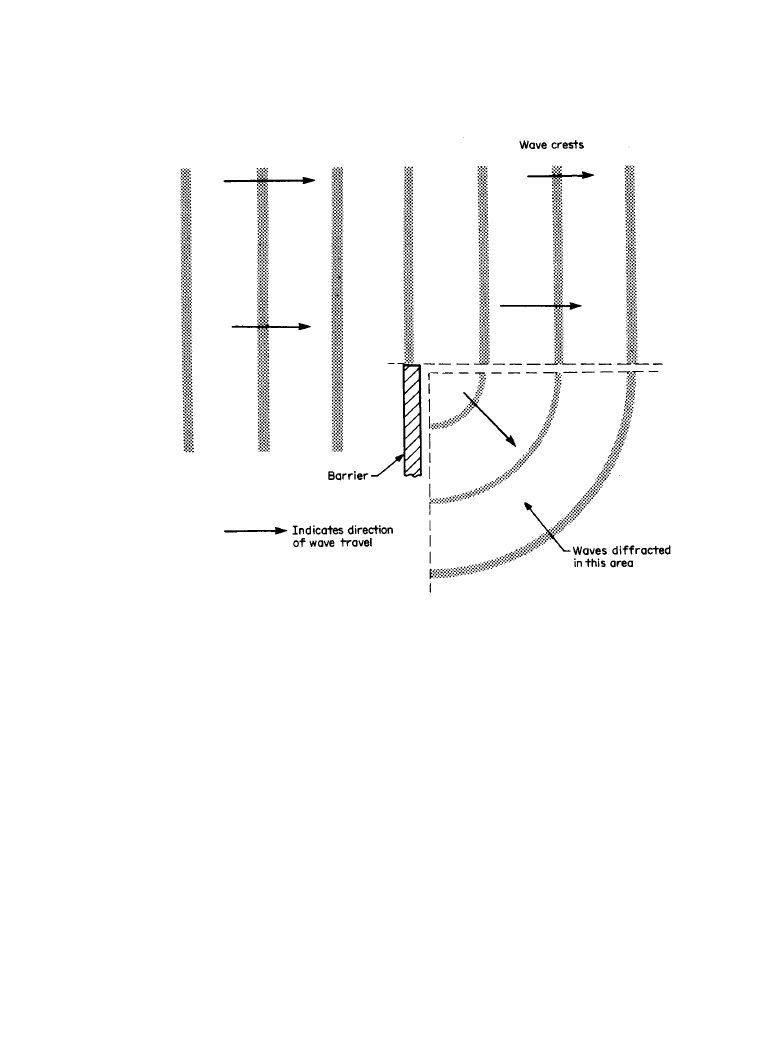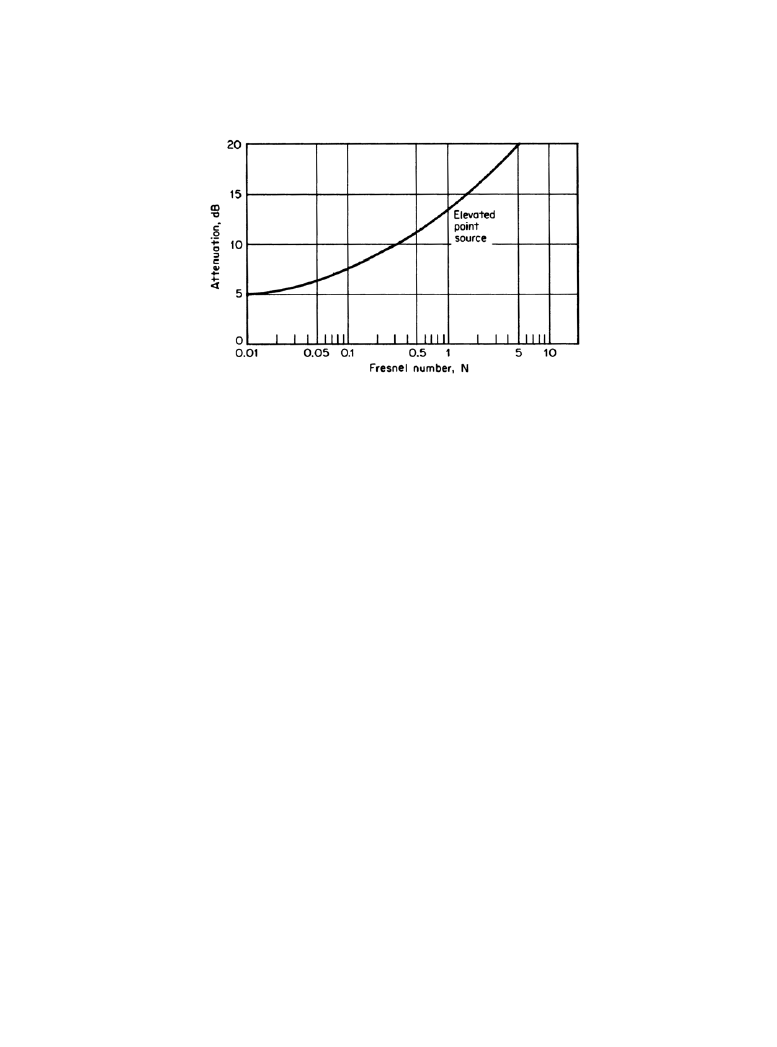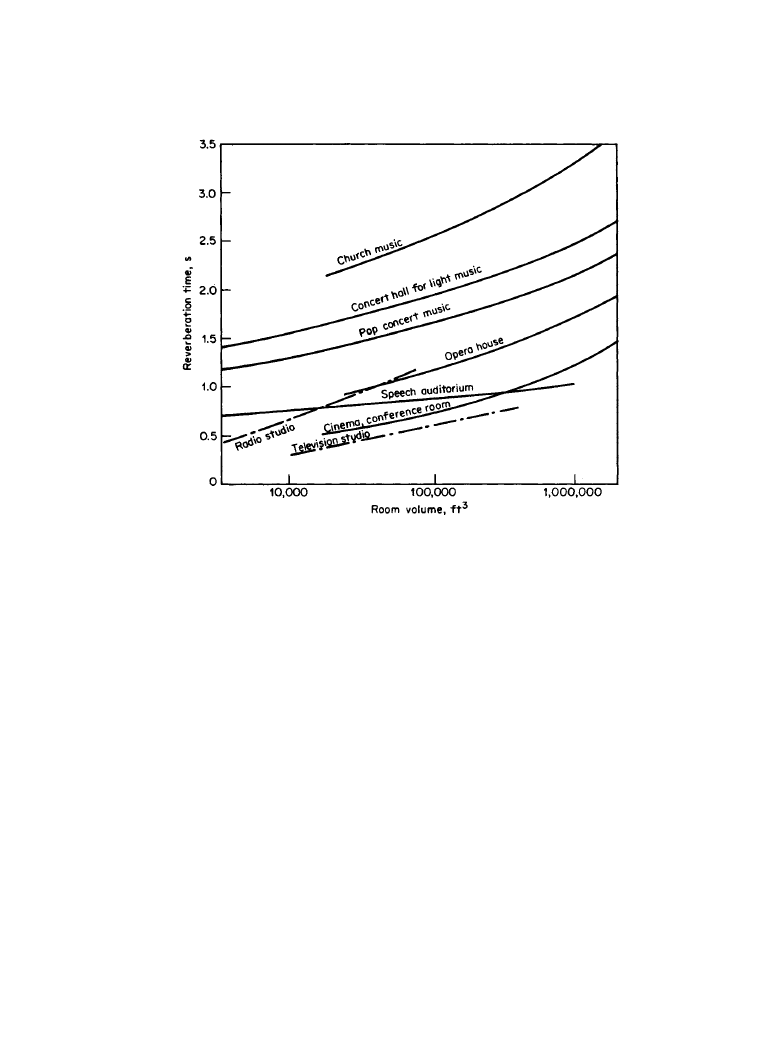ВУЗ: Казахская Национальная Академия Искусств им. Т. Жургенова
Категория: Книга
Дисциплина: Не указана
Добавлен: 03.02.2019
Просмотров: 21617
Скачиваний: 19

3-20 Architectural Acoustic Principles and Design Techniques
3.1.3h
Diffraction
In addition to being reflected or transmitted, sound waves can be diffracted. Figure 3.1.6 shows a
barrier parallel to waves. At the free end of the barrier the waves spread around to the acoustical
shadow area behind. The more the waves turn around the end of the barrier, the more the ampli-
tude of the wave is decreased.
For example, for acoustically simple applications such as for a barrier built around rooftop
equipment, the amount of noise reduction from a barrier depends on the increased distance that
the sound has to travel over the top of the barrier to the listener caused by the insertion of the bar-
rier. For the distance d, which is the additional distance that the sound must travel around the
obstruction to the receiver, the Fresnel number N is defined as
(3.1.15)
Where:
λ = wavelength of sound, ft (m)
N
2d/
λ
=
Figure 3.1.6
Diffraction of sound by a solid barrier.
Downloaded from Digital Engineering Library @ McGraw-Hill (www.digitalengineeringlibrary.com)
Copyright © 2004 The McGraw-Hill Companies. All rights reserved.
Any use is subject to the Terms of Use as given at the website.
The Physical Nature of Sound

The Physical Nature of Sound 3-21
d = total path length from the source over the barrier to the receiver less direct distance separat-
ing source and receiver, ft (m)
Thus, there is a different Fresnel number for each frequency.
From Figure 3.1.7, the noise reduction can be found for each frequency band of interest. It
can be seen that low-frequency sound (with lower N) is attenuated less by diffraction than high-
frequency sound.
3.1.4
References
1.
ASA Standards Index 2, Acoustical Society of America, New York, N.Y., 1980.
2.
Beranek, L. L.: Noise and Vibration Control, McGraw-Hill, New York, N.Y., 1971.
3.
Catalogue of STC and IIC Ratings for Wall and Floor/Ceiling Assemblies, Office of Noise
Control, Berkeley, Calif.
Figure 3.1.7
Noise reduction of a barrier for different Fresnel numbers.
Downloaded from Digital Engineering Library @ McGraw-Hill (www.digitalengineeringlibrary.com)
Copyright © 2004 The McGraw-Hill Companies. All rights reserved.
Any use is subject to the Terms of Use as given at the website.
The Physical Nature of Sound

Downloaded from Digital Engineering Library @ McGraw-Hill (www.digitalengineeringlibrary.com)
Copyright © 2004 The McGraw-Hill Companies. All rights reserved.
Any use is subject to the Terms of Use as given at the website.
The Physical Nature of Sound

3-23
Chapter
3.2
Criteria for Acceptability of Acoustical
Performance
Richard G. Cann, Anthony Hoover
3.2.1
Introduction
Before beginning the acoustical design of any space, one of the first tasks is to establish criteria
for its performance. Sometimes it might appear that this is superfluous, that the owner, architect,
and engineer have an unwritten understanding of acoustical requirements, and that the design
process can begin immediately. However, this is often not the case, and absence of thoughtfully
written criteria may lead to fundamental design errors. The development of criteria is very
important in defining just how spaces will be used and will ultimately determine just how well
the spaces will function acoustically.
3.2.1a
Reverberation Time
For example, if an auditorium will be used for both speech and music, basic design decisions will
have to be made at the outset. Figure 3.2.1 shows a typical plot of reverberation time at 500 Hz
versus room volume for auditoria used for different activities. The preferred reverberation time
for music is approximately twice as long as it is for speech. Either the acoustical quality of some
activities will have to be compromised by selecting a specific reverberation time, or provision
will have to be made for adjusting the reverberation time for each activity.
Though there are generally accepted criteria for the reverberation time of a small auditorium,
they are not nearly so clear-cut for recording studios. Some performers insist on live reverberant
feedback from the space itself and directly from adjacent performers. Other artists, who work
entirely through headphones, are much less concerned about the reverberant quality of a studio.
The former scenario requires an architectural solution, while the latter requires none.
The design criteria for a control room often simply invoke, without acoustical reason, the cur-
rently fashionable proprietary design concept. It seems that no matter which concept is selected,
there are always sound engineers who hate it or love it. There are no generally accepted design
criteria even among those who record the same artist. Remembering that almost all the buying
public never hear a recording with the fidelity available to sound engineers, what the engineers
really want is sound quality that will allow them to project what they hear into the finished disk.
Downloaded from Digital Engineering Library @ McGraw-Hill (www.digitalengineeringlibrary.com)
Copyright © 2004 The McGraw-Hill Companies. All rights reserved.
Any use is subject to the Terms of Use as given at the website.
Source: Standard Handbook of Audio and Radio Engineering

3-24 Architectural Acoustic Principles and Design Techniques
And, of course, that varies from one engineer to the next, according to their past experience.
Therefore, it is wise to build flexibility into control-room design, allowing engineers to produce
their own semicustom setup. No one way is best.
3.2.1b
Background Noise
The background sound level should not interfere with the perception of the desired sound, espe-
cially during quiet periods, for music is a rhythm not only of sound but also of silence. It is
important not to intrude upon the latter with a rumbling fan or traffic noise. The most frequently
used criteria for background noise are the noise-criterion (NC) curves, which are classified
according to space usage in Table 3.2.1. The interior octave-band sound levels are plotted on a
standard graph as shown in Figure 3.2.2. Each NC curve is named according to its value at 500
Hz. The NC value of a plotted spectrum is usually defined by the highest NC value that is
attained in any octave band. For example, the NC value of the spectrum in Figure 3.2.2 is defined
by the sound pressure level at 250 Hz, which gives an NC value of 45.
However, NC curves are applicable only to essentially informationless sound, sound which is
continuous and time-invariant. Where the intruding noise carries meaningful information such as
intelligible speech or countermusical rhythms, more stringent criteria must be applied.
Figure 3.2.1
Typical reverberation times for different sizes of rooms and auditoria according to
usage.
Downloaded from Digital Engineering Library @ McGraw-Hill (www.digitalengineeringlibrary.com)
Copyright © 2004 The McGraw-Hill Companies. All rights reserved.
Any use is subject to the Terms of Use as given at the website.
Criteria for Acceptability of Acoustical Performance